Arm SUBARU FORESTER 2003 SG / 2.G Owners Manual
[x] Cancel search | Manufacturer: SUBARU, Model Year: 2003, Model line: FORESTER, Model: SUBARU FORESTER 2003 SG / 2.GPages: 420, PDF Size: 4.4 MB
Page 10 of 420

7
–
CONTINUED –
ment, the driver should always sit upright and
well back in the seat as far from the steering
wheel as practical while still maintaining full ve-
hicle control and the front passenger should
move the seat as far back as possible and sit
upright and well back in the seat.
Carefully read the sections “Seatbelts” and “*SRS air-
bag (Supplemental Restraint System airbag)” in chap-
ter 1 of this owner’s manual for instructions and
precautions concerning the seatbelt system and SRS
airbag system. � Child safety
�Never hold a child on your lap or in your arms
while the vehicle is moving. The passenger
cannot protect the child from injury in a colli-
sion, because the child will be caught between
the passenger and objects inside the vehicle. � While riding in the vehicle, infants and small
children should always be placed in the REAR
seat in an infant or child restraint system which
is appropriate for the child
Page 14 of 420
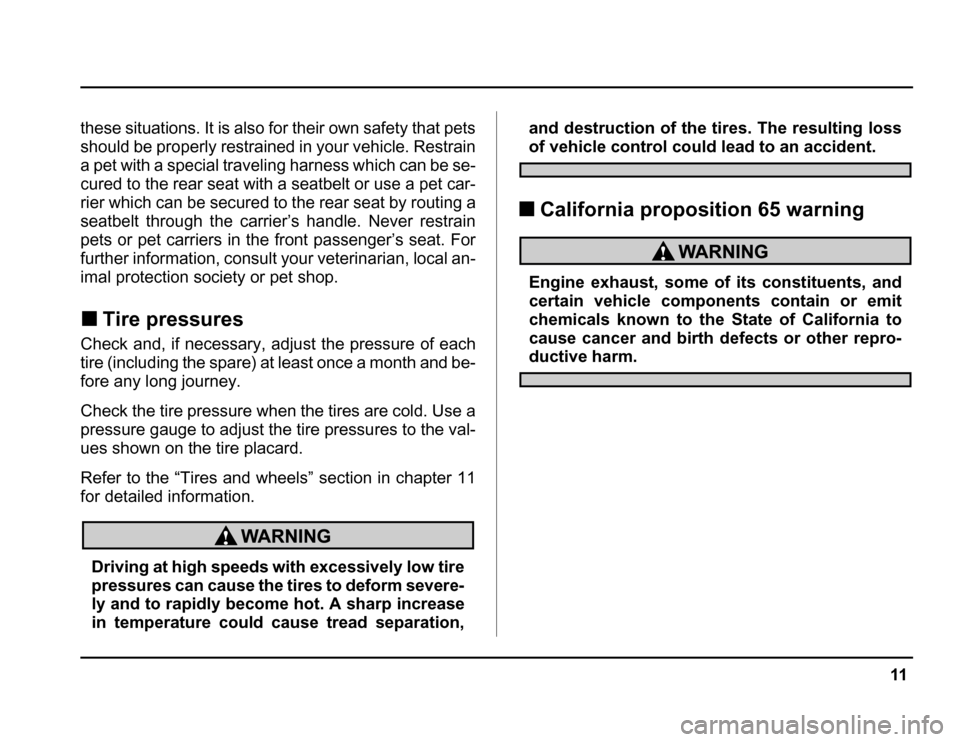
11
–
CONTINUED –
these situations. It is also for their own safety that pets
should be properly restrained in your vehicle. Restrain
a pet with a special traveling harness which can be se-
cured to the rear seat with a seatbelt or use a pet car-
rier which can be secured to the rear seat by routing a
seatbelt through the carrier’s handle. Never restrain
pets or pet carriers in the front passenger’s seat. For
further information, consult yo ur veterinarian, local an-
imal protection society or pet shop. � Tire pressures
Check and, if necessary, adjust the pressure of each
tire (including the spare) at least once a month and be-
fore any long journey.
Check the tire pressure when the tires are cold. Use a
pressure gauge to adjust the tire pressures to the val-
ues shown on the tire placard.
Refer to the “Tires and wheels” section in chapter 11
for detailed information.
Driving at high speeds with excessively low tire
pressures can cause the tires to deform severe-
ly and to rapidly become hot. A sharp increase
in temperature could cause tread separation, and destruction of the tires. The resulting loss
of vehicle control could lead to an accident.
� California proposition 65 warning
Engine exhaust, some of its constituents, and
certain vehicle components contain or emit
chemicals known to the State of California to
cause cancer and birth defects or other repro-
ductive harm.
Page 35 of 420

1-8
Seat, seatbelt and SRS airbags
Seat heater (if equipped)
The seat heater operates when the ignition switch is
either in the “ACC” or “ON” position.
To turn on the seat heater, push the “LO” or “HI” posi-
tion on the switch, as desired, depending on the tem-
perature. Selecting the “HI” position will cause the seat
to heat up quicker.
1)
HI— Rapid heating
2) LO – Normal heating
The indicator located on the switch comes on when
the seat heater is in operation. When the vehicle’s in-
terior is warmed enough or before you leave the vehi-
cle, be sure to turn the switch off.
� There is a possibility that people with delicate
skin may suffer slight burns even at low tem-
peratures if he/she uses the seat heater for a
long period of time. When using the heater, al-
ways be sure to warn the persons concerned.
HS1041BA
1
2
HS1042BB
Page 43 of 420
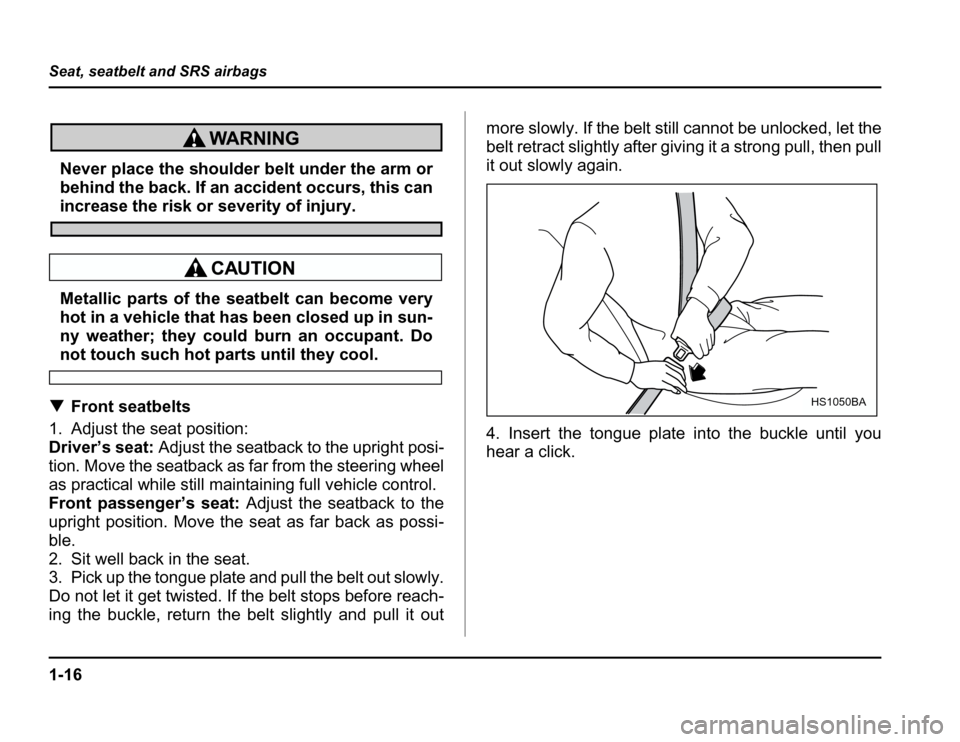
1-16
Seat, seatbelt and SRS airbags
Never place the shoulder belt under the arm or
behind the back. If an accident occurs, this can
increase the risk or severity of injury.
Metallic parts of the seatbelt can become very
hot in a vehicle that has been closed up in sun-
ny weather; they could burn an occupant. Do
not touch such hot parts until they cool.
� Front seatbelts
1. Adjust the seat position:
Driver
Page 53 of 420

1-26
Seat, seatbelt and SRS airbags
�
Do not allow the retractor to roll up the seat-
belt too quickly. Otherwise, the metal tongue
plates may hit against the trim, resulting in
damaged trim. � Have the seatbelt fully rolled up so that the
tongue plates are neatly stored. A hanging
tongue plate can swing and hit against the trim
during driving, causing damage to the trim. �
Seatbelt maintenance
To clean the seatbelts, use a mild soap and lukewarm
water. Never bleach or dye the belts because this
could seriously affect their strength.
Inspect the seatbelts and attachments including the
webbing and all hardware periodically for cracks, cuts,
gashes, tears, damage, loose bolts or worn areas. Re-
place the seatbelts even if only minor damage is
found.
� Keep the belts free of polishes, oils, chemi-
cals and particularly battery acid. � Never attempt to make modifications or
changes that will prevent the seatbelt from op-
erating properly.
HS1066BA
Page 54 of 420
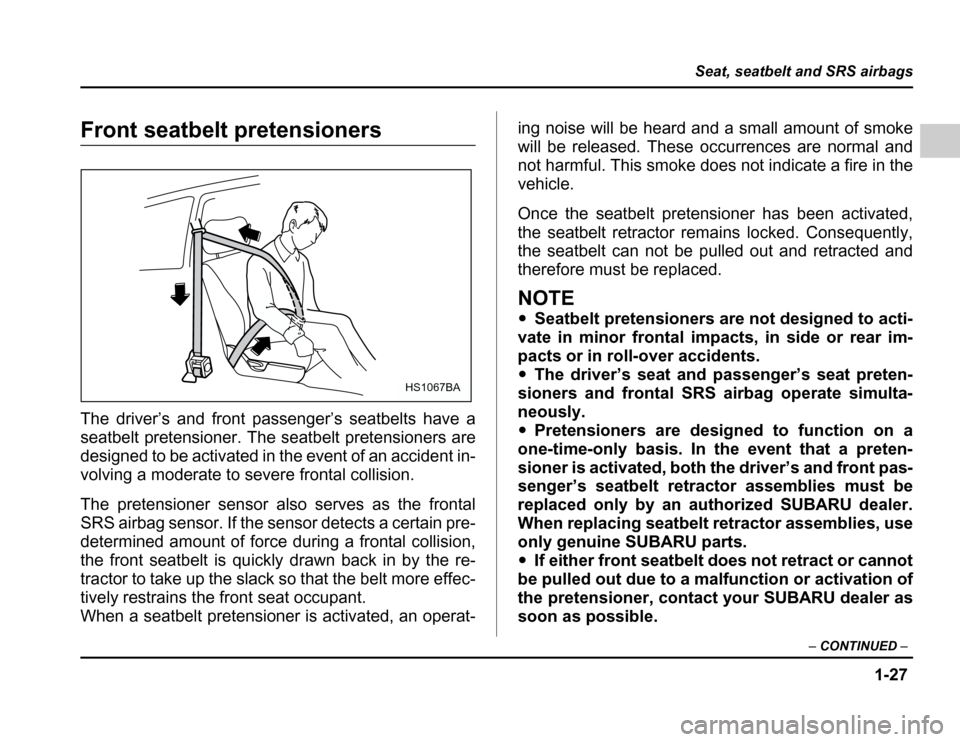
1-27
Seat, seatbelt and SRS airbags
–CONTINUED –
Front seatbelt pretensioners
The driver’s and front passenger’s seatbelts have a
seatbelt pretensioner. The seatbelt pretensioners are
designed to be activated in the event of an accident in-
volving a moderate to severe frontal collision.
The pretensioner sensor also serves as the frontal
SRS airbag sensor. If the sensor detects a certain pre-
determined amount of force during a frontal collision,
the front seatbelt is quickly drawn back in by the re-
tractor to take up the slack so that the belt more effec-
tively restrains the front seat occupant.
When a seatbelt pretensioner is activated, an operat- ing noise will be heard and a small amount of smoke
will be released. These occurrences are normal and
not harmful. This smoke does not indicate a fire in the
vehicle.
Once the seatbelt pretensioner has been activated,
the seatbelt retractor remains locked. Consequently,
the seatbelt can not be pulled out and retracted and
therefore must be replaced.
NOTE �
Seatbelt pretensioners are not designed to acti-
vate in minor frontal impacts, in side or rear im-
pacts or in roll-over accidents. � The driver
Page 58 of 420
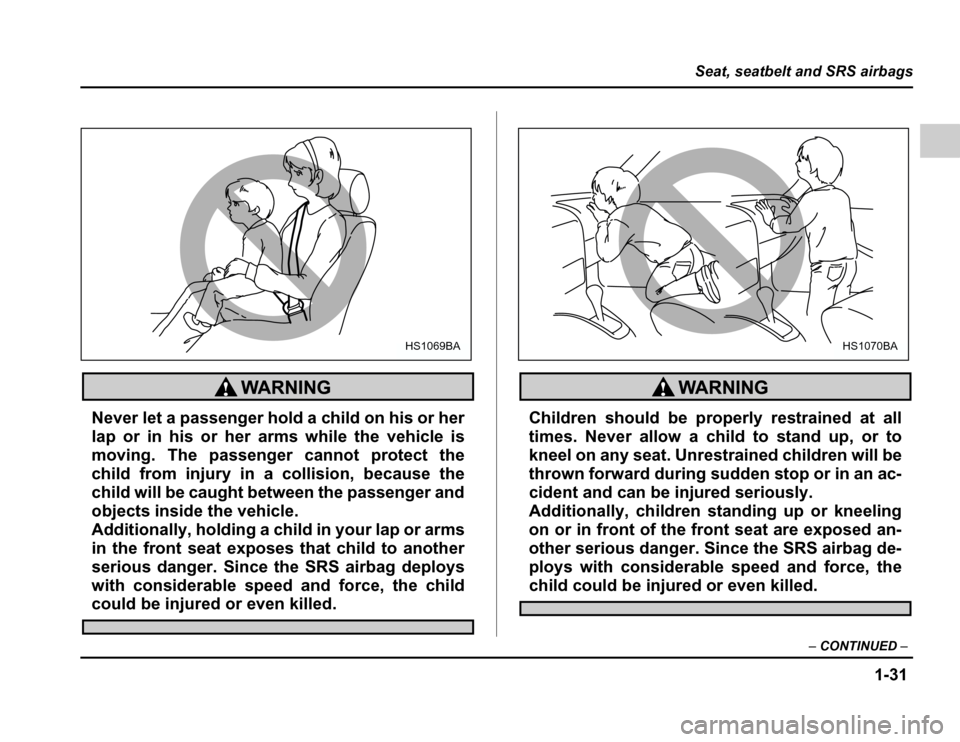
1-31
Seat, seatbelt and SRS airbags
–CONTINUED –
Never let a passenger hold a child on his or her
lap or in his or her arms while the vehicle is
moving. The passenger cannot protect the
child from injury in a collision, because the
child will be caught between the passenger and
objects inside the vehicle.
Additionally, holding a child in your lap or arms
in the front seat exposes that child to another
serious danger. Since the SRS airbag deploys
with considerable speed and force, the child
could be injured or even killed.
Children should be properly restrained at all
times. Never allow a child to stand up, or to
kneel on any seat. Unrestrained children will be
thrownforwardduringsuddenstoporinanac-
cident and can be injured seriously.
Additionally,childrenstandinguporkneeling
on or in front of the front seat are exposed an-
other serious danger. Since the SRS airbag de-
ploys with considerable speed and force, the
child could be injured or even killed.
HS1069BAHS1070BA
Page 67 of 420

1-40
Seat, seatbelt and SRS airbags
vehicle should always wear seatbelts when the
vehicle is moving. The SRS airbag is designed
only as a supplement to the primary protection
provided by the seatbelt. It does not do away
with the need to fasten seatbelts. In combina-
tion with the seatbelts, it offers the best com-
bined protection in case of a serious accident.
Not wearing a seatbelt increases the chance of
severe injury or death in a crash even when the
car has the SRS airbag.
For instructions and precautions concerning
the seatbelt system, see the “Seatbelts” sec-
tions in this chapter. �
Do not sit or lean unnecessarily close to the
SRS airbag. Because the SRS airbag deploys
with considerable speed – faster than the blink
of an eye – and force to protect in high speed
collisions, the force of an airbag can injure an
occupant whose body is too close to SRS air-
bag.
It is also important to wear your seatbelt to help
avoid injuries that can result when the SRS air-
bag contacts an occupant not in proper posi-
tion such as one thrown forward during pre-
accident braking.
Even when properly positioned, there remains
a possibility that an occupant may suffer minor injury such as abrasions and bruises to the
face or arms because of the SRS airbag deploy-
ment force. �
The SRS airbags deploy with considerable
speed and force. Occupants who are out of
proper position when the SRS airbag deploys
could suffer very serious injuries. Because the
SRS airbag needs enough space for deploy-
ment, the driver should always sit upright and
well back in the seat as far from the steering
wheel as practical while sti ll maintaining full ve-
hicle control and the front passenger should
move the seat as far back as possible and sit
upright and well back in the seat.� Do not place any objects over or near the
SRS airbag cover or between you and the SRS
airbag. If the SRS airbag deploys, those objects
could interfere with its proper operation and
could be propelled inside the car and cause in-
jury.
Page 72 of 420
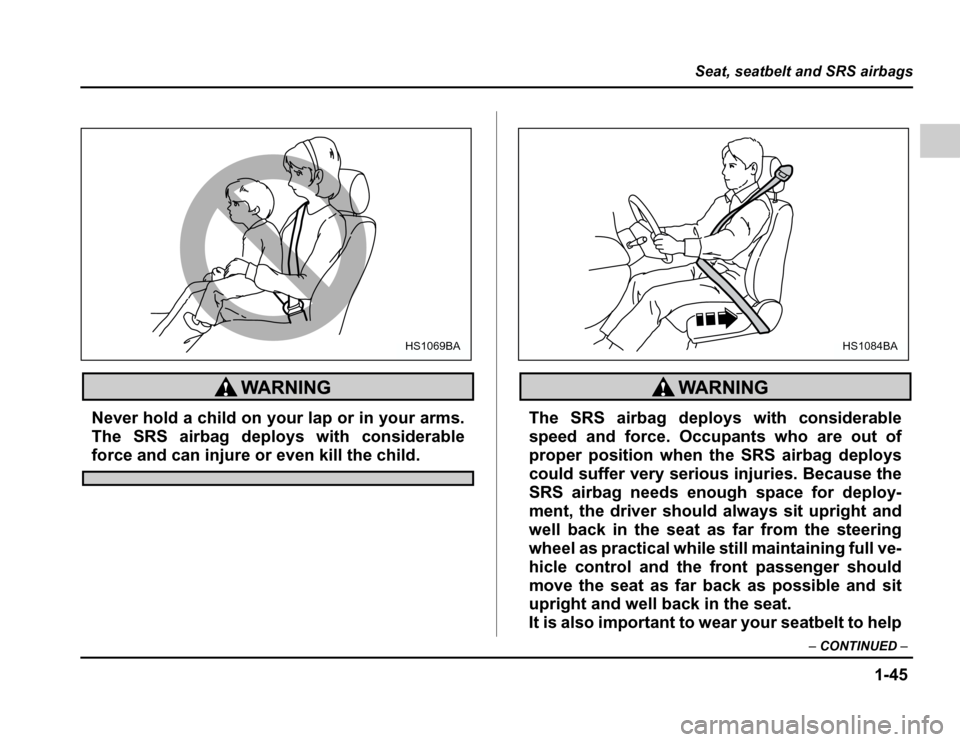
1-45
Seat, seatbelt and SRS airbags
–CONTINUED –
Never hold a child on your lap or in your arms.
The SRS airbag deploys with considerable
force and can injure or even kill the child.
The SRS airbag deploys with considerable
speed and force. Occupants who are out of
proper position when the SRS airbag deploys
could suffer very serious injuries. Because the
SRS airbag needs enough space for deploy-
ment, the driver should always sit upright and
well back in the seat as far from the steering
wheel as practical while still maintaining full ve-
hicle control and the front passenger should
move the seat as far back as possible and sit
upright and well back in the seat.
It is also important to wear your seatbelt to help
HS1069BAHS1084BA
Page 80 of 420
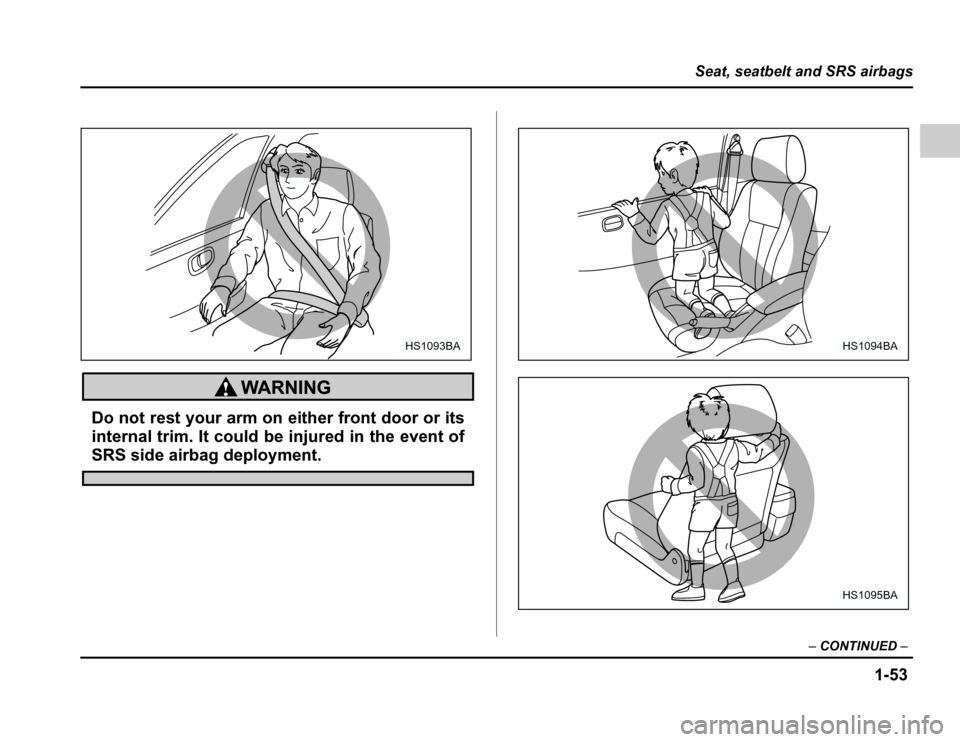
1-53
Seat, seatbelt and SRS airbags
–CONTINUED –
Do not rest your arm on either front door or its
internal trim. It could be injured in the event of
SRS side airbag deployment.
HS1093BAHS1094BA
HS1095BA